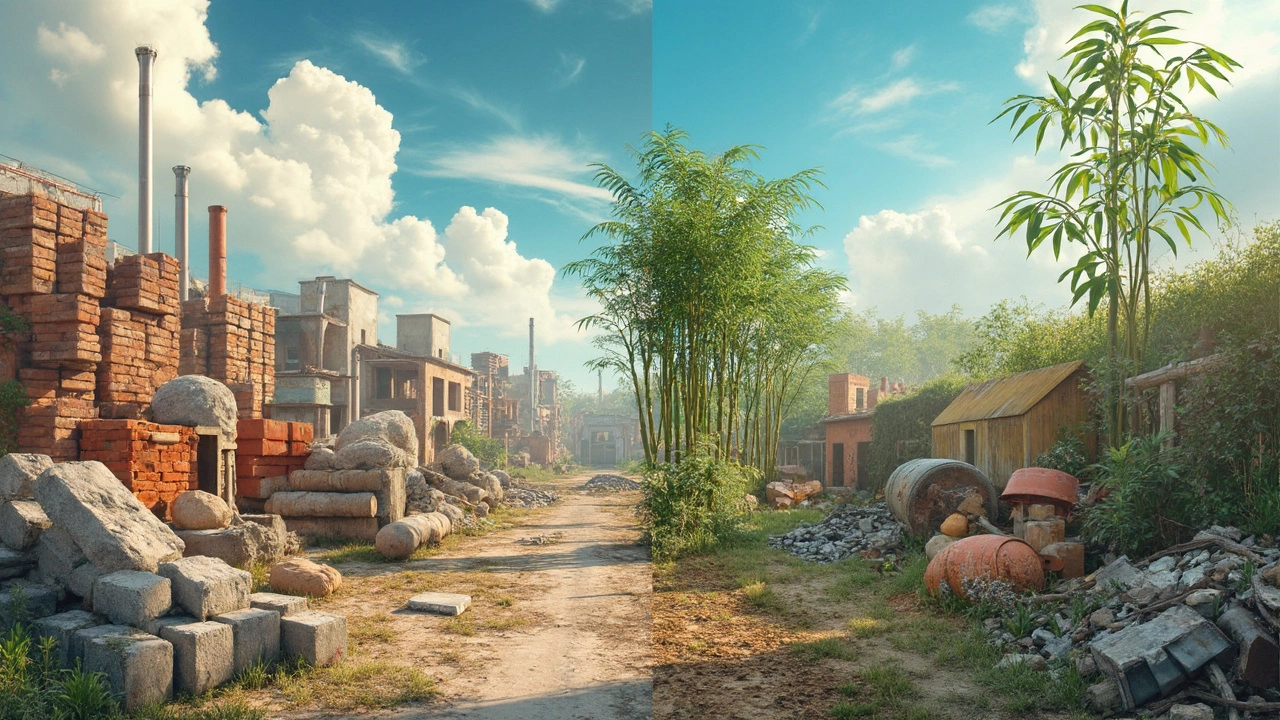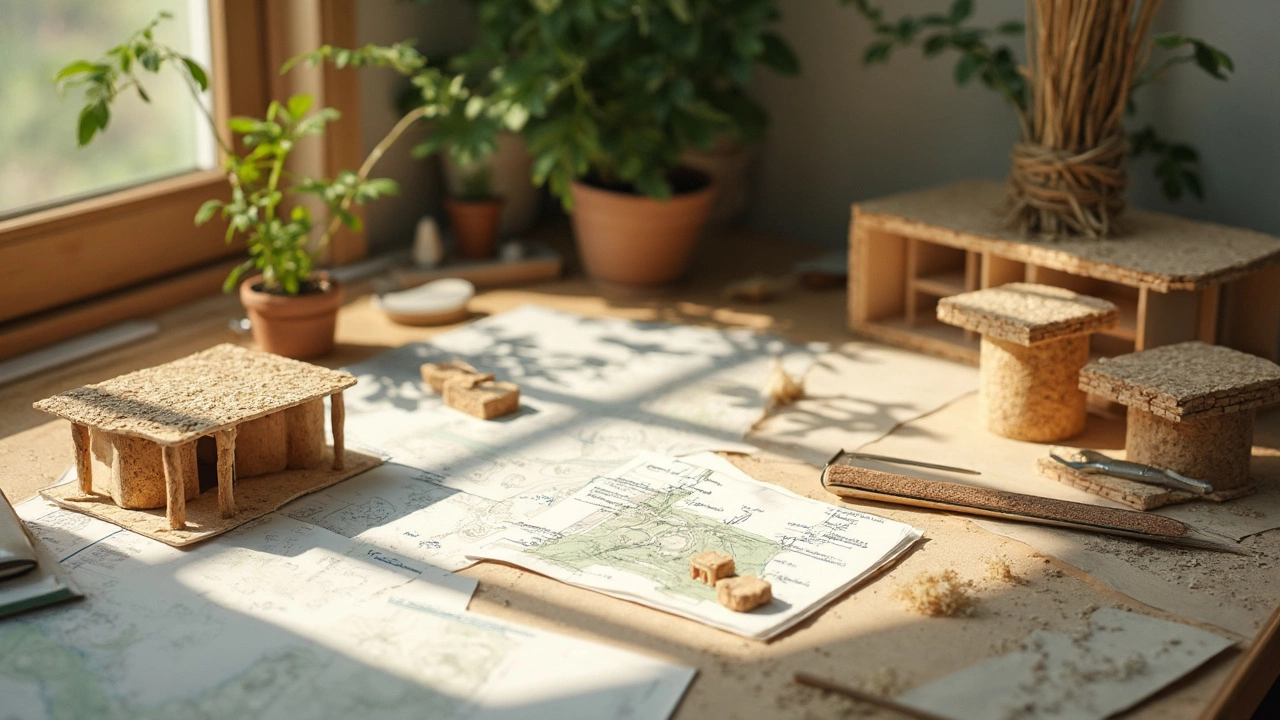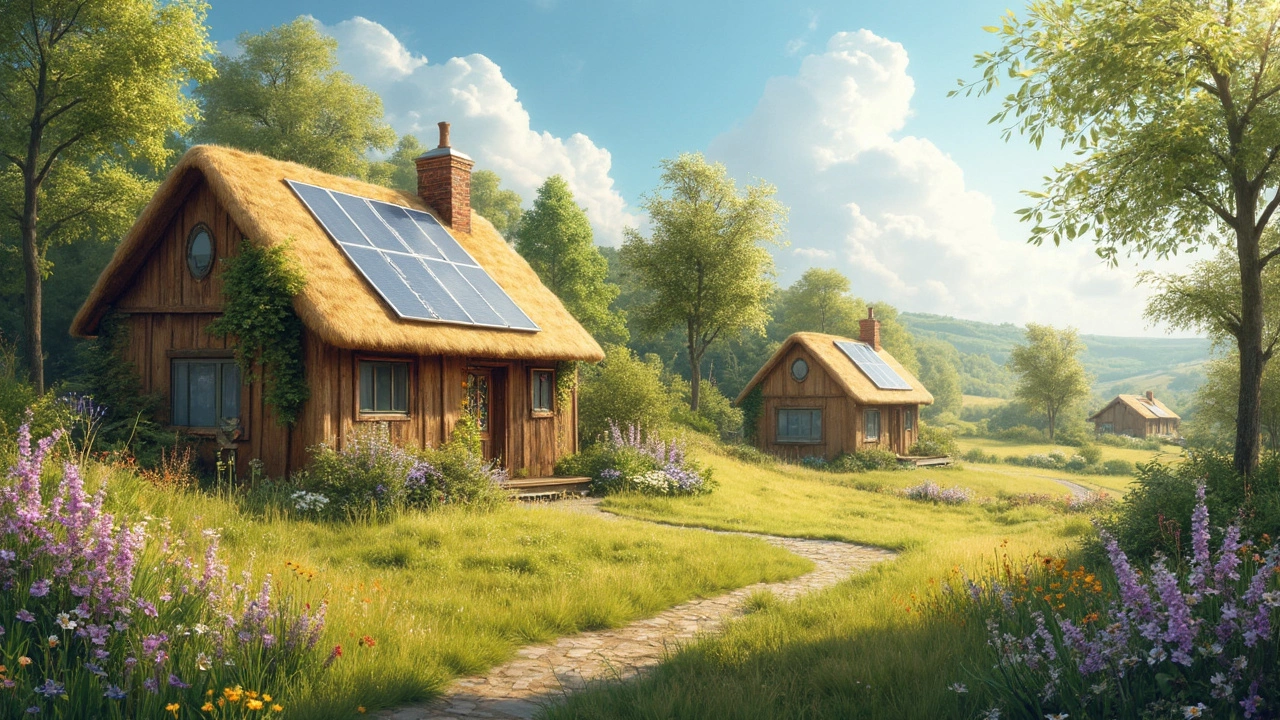Building an eco-friendly cottage isn't just a trend; it's a smart way to contribute to saving the planet. But did you know that some of the most commonly used building materials are not so kind to Mother Earth? Let's kick off with concrete and cement. These guys might be sturdy and strong, but producing them generates a hefty amount of carbon dioxide. Believe it or not, the cement industry alone accounts for around 8% of the world's CO2 emissions. That's a staggering number for just one building material!
Next up, timber. Growing trees seem pretty eco-friendly, right? But watch out! Timber from non-sustainable sources contributes to deforestation, a major environmental issue. To keep things green, look out for timber with certifications like FSC or PEFC, which ensure wood comes from responsibly managed forests.
And plastics? You might love them for their durability and low cost, but most end up in landfills, taking hundreds of years to break down. Plus, they’re often made from petroleum, which isn’t exactly renewable. Consider swapping out some of that plastic for materials like bamboo or recycled wood for a greener touch.
Building with steel and metals isn’t much better. While they’re great for strength and durability, mining and production are energy-intensive and polluting. Recycling metals is a good way to cut back on emissions, but reducing reliance on them in the first place is even better!
Last but not least, asphalt and traditional roofing materials can leak toxic chemicals into the environment. They’re not the worst offenders but when heavy rains hit, those toxins can make their way into water systems. Alternatives like recycled metal or solar tiles might take a bit more upfront investment but pay off as a sustainable choice in the long run.
- Concrete and Cement: Environmental Giants
- The Not-So-Green Side of Timber
- Plastics: Convenience vs. Conservation
- Steel and Metals: Heavyweights in Pollution
- Asphalt and Roofing Materials
Concrete and Cement: Environmental Giants
When it comes to building materials, concrete and cement are some of the most widely used around the globe, thanks to their durability and versatility. But there's a catch: they're also among the least eco-friendly materials out there.
Why, you ask? It's all about how they're produced. Making cement involves heating limestone with other materials to a whopping 1450°C (that’s hotter than flowing lava!). This process, called calcination, releases carbon dioxide (CO2) as the limestone decomposes. Add in the emissions from burning fossil fuels to reach those high temperatures, and you've got a veritable CO2 powerhouse claiming about 8% of global emissions.
Thought-provoking Stats
| Factor | Global Impact |
|---|---|
| Concrete Production | ~30 billion tons/year |
| Cement Industry CO2 Emissions | 8% of the world's total |
| Water Usage | Approx. 10% of global industrial water use |
Looking for Greener Pastures
Now, if you’re thinking about going sustainable with your cottage build, there are a few alternatives. One of them is using fly ash or slag instead of traditional cement, which can reduce the carbon footprint of concrete. Fly ash is a byproduct of coal combustion, while slag comes from iron smelting. Both materials help create a stronger, longer-lasting concrete with less environmental impact.
Swap Concrete Wisely
- Consider using locally sourced gravel to cut transportation emissions.
- Think about using recycled aggregates. Believe it or not, old concrete can be crushed and reused!
- Explore permeable concrete options for driveways or walkways, which also help with water drainage.
While concrete isn't going to disappear anytime soon, being mindful of these alternatives can surely help in building more eco-friendly cottages and reducing our overall environmental footprint. Small changes can lead to big differences.
The Not-So-Green Side of Timber
Timber seems like a no-brainer for eco-friendly building materials. Trees grow back, right? But not all timber is equal in terms of environmental impact. Let's dig into why.
Deforestation and Loss of Biodiversity
Many forests are poorly managed, resulting in deforestation that wipes out huge swathes of trees. This not only reduces CO2 absorption but also destroys habitats for countless species. When you're building your dream eco-friendly cottage, it's vital to ensure your wood is sourced sustainably.
Sourcing Sustainable Timber
How do you know you're getting the good stuff? Look for certifications like FSC (Forest Stewardship Council) or PEFC (Programme for the Endorsement of Forest Certification). These labels mean the wood comes from responsibly managed forests that prioritize renewal and biodiversity.
Treatment and Chemicals
Here's something you might not know: a lot of timber is treated with chemicals to prevent rot and pests. While that's great for durability, those chemicals can leach into the environment over time, posing risks to both ecosystems and people. Consider using naturally durable woods like cedar or opt for non-toxic treatments.
Carbon Footprint of Processing
The journey from tree to timber involves cutting, processing, and transporting—all of which contribute to carbon emissions. Aiming for locally sourced timber can drastically cut down on these emissions by reducing transport distances.
| Timber Type | CO2 Emission (kg/m³) |
|---|---|
| Pine | 46 |
| Spruce | 48 |
| Oak | 59 |
The table above shows the CO2 emissions for each type of timber. Opting for less processed woods with a lower emission footprint can help keep your cottage as green as the day it was built.
Reclaimed Wood
One cool option is using reclaimed wood. This wood has already served its purpose elsewhere and is repurposed for your project. Not only does this mean less demand for new timber, but it adds a unique touch to your cottage, with each piece bringing a bit of history.

Plastics: Convenience vs. Conservation
Plastics are everywhere. They're in our homes, our building materials, and even our grocery bags. It’s no surprise that they’ve crept into construction, too. But while they're convenient and inexpensive, they're a headache for the environment.
Think about this: most plastics are derived from petroleum, a non-renewable resource. That means every plastic window frame, pipe, or insulation panel represents a piece of our ecosystem eaten up by fossil fuel extraction. What’s more, when these materials are disposed of, they take a staggering amount of time to decompose—sometimes up to 500 years. During this time, they can release toxic chemicals into the soil and waterways.
Impact on the Environment
One of the biggest problems with plastic in eco-friendly cottages is that it contributes to landfill overload. Globally, about 300 million tons of plastic are produced every year, and a large chunk of that ends up as waste. Imagine layers upon layers of discarded plastic, leaching chemicals that seep into our groundwater—definitely not the greenest choice.
Potential Alternatives
So, what can you do when you're planning your eco-friendly paradise? Here are some ideas:
- Recycled Plastic: If you can't avoid plastic, go for the recycled type. It requires less energy to produce and helps reduce landfill waste.
- Natural Fiber Materials: Instead of plastic-based products, consider using natural fibers like hemp or flax for insulation and furnishings.
- Bamboo: It’s fast-growing and strong, making it a great alternative for items that typically use plastic.
Interesting Stats
Let's look at some numbers. The recycling rate for plastics is low—only about 9% in most countries. On the flip side, over 40% of the plastic produced is used for single-use products, which often land in our oceans.
Incorporating sustainable practices in construction isn't just about ditching certain materials. It's about making informed decisions and balancing the conveniences with the long-term impacts. With a few thoughtful choices, your cottage can be a personal retreat that also respects the planet.
Steel and Metals: Heavyweights in Pollution
Steel and metals are like the bouncers of the building world—tough, reliable, and practically essential for modern construction. But did you know they come with a hefty environmental price tag? The production of steel alone contributes to about 7%-9% of total global CO2 emissions. That's a massive chunk! This goes to show that while metals are durable, their production can be a major pollutant.
Production Impact
The process of transforming raw iron ore into steel requires enormous amounts of energy. We're talking about temperatures of around 1,500 degrees Celsius! Not to mention, this process also relies heavily on fossil fuels, which isn't exactly helping our eco-friendly goals. The energy consumption alone is substantial, and the carbon emissions are equally daunting.
While metals are super recyclable—which is a bright spot—only about 30% of new steel comes from recycled material today. Imagine if that number could be increased! It's like giving metals a second life, without the hefty pollution legacy.
Alternatives and Improvements
So, what can we do about all this? Well, some manufacturers are turning to electric arc furnaces powered by renewable energy. These furnaces are far less polluting than traditional production methods using blast furnaces. However, it's still a rising trend and not as widespread as we'd hope.
Sustainable construction enthusiasts often look for reclaimed or recycled metals. This isn't just easier on the environment, but it can also save a few bucks. If you're building an eco-friendly cottage, consider sourcing these greener metal options.
There's also an emerging push towards using lighter metal alloys or composites that require less energy to produce and transport. These innovations show promise, but broad market adoption is still developing.
Want a quick look at how metals stack up environmentally? Here's a handy little table:
| Material | Energy Intensity | CO2 Emissions (per ton) |
|---|---|---|
| Steel | High | ~1.85 tons |
| Aluminium | Very High | ~8.8 tons |
| Copper | Moderate | ~3.9 tons |
By opting for more sustainable options and focusing on recycling, we can reduce the carbon footprint of our metal use. So, when you're considering materials for your build, think about ways to minimize the environmental impact without sacrificing the strength and durability metal offers.

Asphalt and Roofing Materials
Ah, roofing materials! We often don't think much about what sits over our heads, but when talking about eco-friendly cottages, it’s important to get clued up. First up, let’s tackle asphalt roofing. It’s super common, for sure, used on about 75% of homes in the U.S.
While asphalt shingles are popular for their affordability and ease of installation, they're not winning any awards for sustainability. You see, asphalt is a petroleum-based product. The extraction and refining processes are energy-intensive and have a hefty carbon footprint.
Environmental Impact
One of the bigger concerns with asphalt shingles is the chemical run-off they can produce. During heavy rain, chemicals from these shingles can seep into our water systems, causing potential harm to aquatic life. Plus, they don’t last forever. When they need replacing, they often end up in landfills, taking decades to decompose.
Greener Alternatives
Luckily, there are some greener alternatives to consider for your roofing needs. Check these out:
- Metal Roofing: Although it might have higher initial costs, it's durable and often made from recycled materials, plus it's fully recyclable at the end of its life.
- Solar Tiles: Marry energy efficiency with sustainability. While pricy upfront, they can offer significant long-term savings on energy bills.
- Green Roofs: These incorporate vegetation and bring loads of benefits like reduced stormwater runoff and better insulation.
For those really looking to make a change and embrace sustainable construction, making a conscious roof material choice can be a game-changer.
Cost Comparison
| Material | Initial Cost | Longevity |
|---|---|---|
| Asphalt Shingles | Low | 15-20 years |
| Metal Roofing | High | 40-70 years |
| Solar Tiles | Very High | 25-50 years |
| Green Roofs | Medium-High | 30-50 years |
Making informed decisions around roofing materials can help align with eco-friendly construction principles and provide a more sustainable future for eco-friendly cottages.

